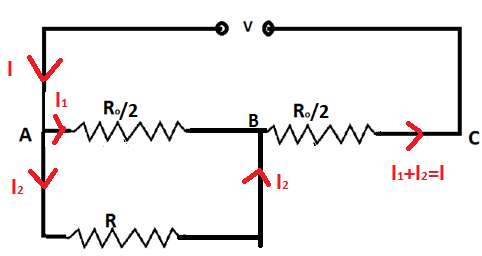Question
Question: A resistance of \(R \Omega\) draws current from a potentiometer as shown in the figure. The potentio...
A resistance of RΩ draws current from a potentiometer as shown in the figure. The potentiometer has a total resistance R0Ω. A voltage V is supplied to the potentiometer. Derive an expression for the voltage across R when the sliding contact is in the middle of the potentiometer.

Solution
A potentiometer circuit is called balanced when the voltage drop across the sliding resistance is equal to the resistance of the wire it traversed. In this the voltage drop across the length of the wire the slider traversed will be equal to the voltage drop across the slider i.e both will be in parallel connection.
Complete step by step solution:
Here in this question, it is given that the resistance r drives current from the potentiometer
And we need to derive an equation for voltage Across when the sliding contact is at the center i.e. at B .
Now, Here it is given that we have to derive the equation when the contact is in the middle so we can say that AB=2AC.
Now as we know that resistance of a wire depends upon length and area
R∝AL
To remove the constant of proportionality we introduce ρ which is called resistivity and is the property of the wire material
So the equation becomes, R=AρL
Here we can see that the resistance of the wire is directly proportional to the length and in this case we are reducing the wire length R0 by half
So resistance Rab=2R0
Now our circuit looks like

As here we can see that
Current I is flowing from the source then at it is divided into I1 and I2
Now I1 flows across 2R0
And I2 flows across R
Not at B both streams join each other and currentI1 and I2 re-joins and flows through the resistance RBC

From here we can conclude that since the current is dividing between RABand R hence they are parallel to each other and their equivalent resistance will be in series connection with RBC
Equivalent resistance when resistances are in parallel connection is given by
Req1=R11+R21
So here it will be
Req1=2R01+R1
⇒Req=2R+R0R0R(1)
Now our circuit looks like

Now we will again find equivalent resistance for the remaining circuit
As we can see that this resistance are in series connection and equivalent resistance in series is given by
Rs=Req+RBC
Substituting values we get
Rs=2R+R0R0R+2R0
⇒Rs=R0[2(2R+R0)2R+2R+R0]
⇒RS=2R0×(R0+2R)(R0+4R)
So our equivalent resistance will be RS=2R0×(R0+2R)(R0+4R)
This resistance will be for the whole circuit
Now we have got our equivalent resistance
Apply ohm's law on the circuit
V=IRs
Substituting the value of resistance we get
V=I×[2R0×(R0+2R)(R0+4R)]
⇒I=R0(R0+4R)2V(R0+2R)_________(2)
Now we need to drive expression for voltage across R
Let the voltage across R be V1
Since RAB and R are in parallel so the voltage across them will be the same
So as we know that if the potentiometer needs to be balanced the voltage across AB should be equal to the voltage drop across R
So we will apply ohm's law here also
Applying Ohm's law to the equivalent resistance of RAB and R we get
∵V=IR
here substituting the value of R as Req
Substituting value I from equation 2 and value of Reqfrom equation 1 we get
V1=R0(R0+4R)2V(R0+2R)×2R+R0R0R
⇒V1=R0+4R2VR
The voltage drop across the slider resistance R will be R0+4R2VR.
Note: When current gets divided into two branches it implies that they are in parallel connection. In a parallel connection, the voltage across the joined resistance remains the same. When current passes through resistances added without getting divided then resistances are in series connection in this case the voltage gets divided.
